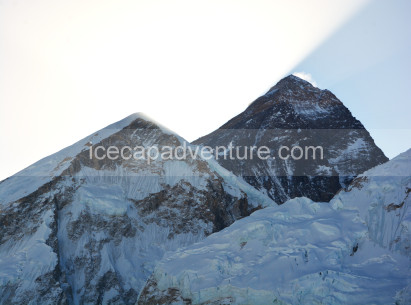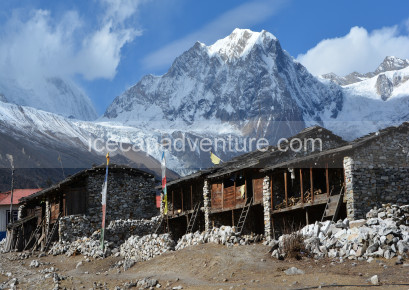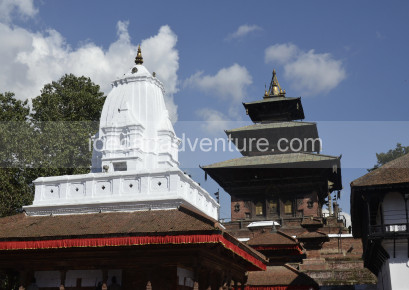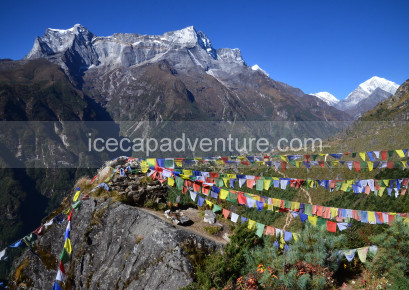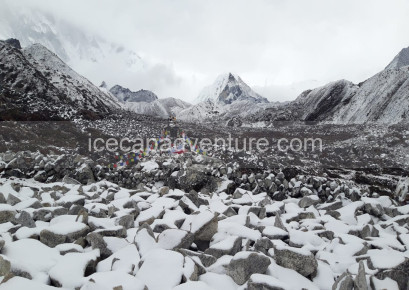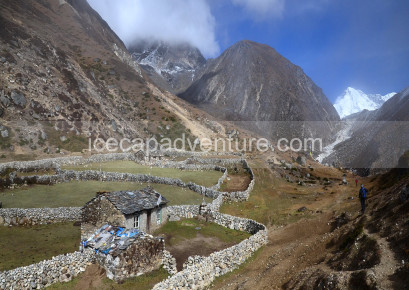.png)
.png)
.png)
.png)
.png)
.png)
.png)
.png)
Mera Peak climbing represents a quintessential mountain expedition, leading adventurers to the apex of the highest trekking peak in Nepal's Himalayas. Situated within the esteemed Everest region, Mera Peak is part of the Mahalangur subrange, which features three prominent summits: Mera South (6,065 m), Mera Central (6,461 m), and Mera North (6,467 m).
Our 16-day itinerary is designed to culminate in the ascent of Mera North Peak. In recent years, the Mera Peak climb has gained significant traction among climbers. It is recognized as an ideal practice peak in the Himalayas, providing aspiring mountaineers with opportunities to refine their skills and bolster their confidence for future climbs.
The Mera Peak expedition serves as an excellent option for novice climbers seeking to gain experience in high-altitude trekking while embarking on an introductory climbing journey. The Mera Peak climb offers an exhilarating experience suitable for both novice mountaineers and experienced climbers alike. The breathtaking vistas of the world's five tallest mountains—Everest, Makalu, Kanchenjunga, Cho Oyu, and Lhotse—visible from the summit are truly indescribable. Additionally, climbers can appreciate the vast panorama of numerous surrounding peaks.
While Mera Peak is not the most formidable mountain, it is certainly not the simplest. Although the majority of the climbing routes are straightforward, there are several technical sections to navigate. With proper preparation, training, and appropriate gear, climbers can undertake this expedition with confidence and success. Furthermore, Exciting Nepal provides a comprehensive guided Mera Peak climbing package designed to elevate your mountaineering experience to unprecedented levels.
Mera Peak Summit Day:
The day of the summit is generally regarded as the most demanding and exhilarating segment of the ascent. You will commence your final push towards the summit in the early hours of the morning, often prior to sunrise. The concluding portion of the climb requires a determined effort to reach the peak. The landscape may present various challenges, including snow-covered slopes and potentially exposed ridges. Equipment such as ropes, crampons, and ice axes may be essential. Achieving the summit of Mera Peak is undeniably a significant accomplishment. You will take the opportunity to savor and appreciate the stunning panoramic views, which encompass the five highest mountains in the world: Mt. Everest (8,848 m / 29,031 ft.), Mt. Kanchenjunga (8,586 m / 28,169 ft.), Mt. Lhotse (8,516 m / 27,940 ft.), Mt. Makalu (8,481 m / 27,825 ft.), and Mt. Cho Oyu (8,188 m / 26,864 ft.). After spending some time at the summit, you will commence your descent.
Highlights of Mera Peak Climbing:
-Mera Peak stands as one of the most alluring trekking peaks in Nepal, reaching an elevation of 6000 meters.
-The journey encompasses culturally rich and enchanting villages, with an itinerary thoughtfully crafted to enhance your experience.
-Rewarded with breathtaking views of the five tallest mountains exceeding 8000 meters, including the majestic Mt. Everest (8848.86 meters).
1
We will be waiting to welcome you at Tribhuvan International Airport, Kathmandu, where you will be greeted with a traditional Nepali flower garland to mark your arrival. After the warm welcome, we will drive you to your hotel—approximately 30 minutes during the day and 20 minutes at night.
Upon reaching the Hotel, you will be offered welcome drinks and biscuits, followed by the settlement of your rooms. Once settled, please join us back in the lobby or meeting hall for a briefing about your Peak Climbing program on Mera Peak Climbing, including an introduction to your guide and other relevant details.
Note: If you arrive in Kathmandu at night, these activities will be scheduled for the following day after breakfast and meals.
.png)
.png)
.png)
.png)
2
After breakfast at the hotel, you will have time to explore Kathmandu’s cultural heritage sites, such as Kathmandu Durbar Square, Swayambhunath (Monkey Temple), or Boudhanath Stupa, and you will have the day to prepare for your trek.
Our team will assist you in checking your gear and ensuring you have all the necessary equipment for the journey ahead. If you need to buy or rent any trekking gear, we will guide you to the best shops in Thamel, where you can find quality items at reasonable prices.
In the evening, your trekking guide will conduct a final briefing about the trek and peak climbing, including route details, safety measures, and expected weather conditions. Overnight stay at a hotel in Kathmandu
.png)
.png)
.png)
.png)
3
After breakfast, Your adventure begins with a spectacular mountain flight from Kathmandu to Lukla (2,840m) — a thrilling 35-minute journey offering breathtaking aerial views of the Himalayas, including Mt. Everest, Lhotse, and Ama Dablam. After landing at the famous Tenzing-Hillary Airport, you’ll meet your trekking crew and set off on the first leg of your journey. The trek starts with a gentle climb through charming Sherpa villages, prayer wheels, and mani walls, immersing you in the rich local culture. The trail gradually ascends through a beautiful rhododendron and pine forest, leading you to Chutanga (3,050m) — a peaceful alpine meadow surrounded by rolling hills and mountain ridges. This short yet scenic hike is perfect for acclimatizing to the altitude and preparing for the higher elevations ahead.
Highlights of the Day:
-
Scenic flight from Kathmandu to Lukla with panoramic Himalayan views
-
First steps on the legendary Everest trekking trails
-
Walk through dense rhododendron and pine forests filled with birdsong
-
Experience traditional Sherpa culture and mountain hospitality
-
Overnight stay at Chutanga with serene mountain surroundings — ideal for acclimatization
.png)
.png)
.png)
.png)
4
After breakfast at Chutanga, the trail today leads you on a challenging yet incredibly rewarding trek across the Zatrwa La Pass (4,600m) — your first major high-altitude crossing of the journey. The route begins with a steady uphill climb through dense forests of juniper, birch, and rhododendron, gradually giving way to rugged alpine terrain as you ascend above the tree line. As you gain elevation, you’ll be treated to panoramic mountain views of the Dudh Kosi Valley and surrounding peaks. The final stretch to the pass is steep and demanding, but the reward at the top is simply breathtaking — a sweeping vista of the Kusum Kanguru, Karyolung, and Number Himal ranges stretching across the horizon.
From the top of Zatrwa La, the trail descends gently toward Chhetare(4,300m), a beautiful grazing meadow that literally means “big pasture.” This is a perfect place to rest after a long day’s trek and take in the peaceful mountain atmosphere. The evening at Thuli Kharka is often crisp and clear, offering magical sunset views over the distant ridgelines.
Highlights of the Day:
-
Challenging ascent to Zatrwa La Pass (4,600m) with rewarding Himalayan panoramas
-
Transition from lush rhododendron forest to high alpine landscapes
-
Stunning views of Kusum Kanguru, Karyolung, and other snow-capped peaks
-
Peaceful overnight stay at the scenic alpine meadow of Thuli Kharka
-
First experience of high-altitude trekking and dramatic mountain scenery
.png)
.png)
.png)
.png)
5
After an early breakfast at Chhetare (4,300 m), the trail gently ascends through dense rhododendron and bamboo forests, offering peaceful surroundings and fresh mountain air. As we climb higher, we follow the beautiful Hinku River valley, crossing several small wooden bridges while enjoying the distant sound of the river below. The trail is moderate but steady, with occasional steep sections leading us to higher elevations. Along the way, we pass through charming summer pastures and yak grazing areas, where locals from the nearby villages often bring their animals during the warmer months.
By midday, the forest begins to open up, revealing the first breathtaking views of the Mera Peak range and surrounding snow-capped ridges. The landscape changes dramatically from lush forest to rugged alpine terrain, signaling our approach to Kothe. After about 4 to 5 hours of walking, we finally arrive at Kothe (3,530 m) — a small but scenic settlement nestled beside the Hinku River. Kothe is known for its warm hospitality and beautiful tea houses, making it a perfect place to rest and acclimatize for the next day’s journey toward Tangnag.
Highlights of the Day:
-
Scenic trek through dense rhododendron and bamboo forests
-
Peaceful walk along the Hinku River valley
-
Stunning first views of Mera Peak and nearby mountains
-
Experience of local yak herders’ lifestyle and summer pastures
-
Comfortable overnight stay at Kothe (3,530 m) with warm Sherpa hospitality
.png)
.png)
.png)
.png)
6
After breakfast in Kothe, we begin our scenic journey toward Tangnag (4,358 m) following the beautiful trail along the west bank of the Hinku River. The path gradually ascends through open alpine meadows surrounded by tall pine and juniper trees. As we leave the dense forest behind, the landscape opens up to wide valleys with spectacular views of Mera Peak (6,476 m) and other surrounding peaks. The trail is steady but not too steep, allowing us to walk comfortably while enjoying the natural beauty and fresh mountain air.
Along the way, we pass through Losing and Gondishung, two small summer settlements used by yak herders. At Gondishung, we visit a small ancient Lungsumgba Gompa (Monastery), built over 200 years ago, where local Sherpas often stop to offer prayers for a safe climb to Mera Peak. This spiritual stop adds a special cultural touch to the day’s journey. Continuing further, the trail follows the river upstream and finally reaches the broad pastureland of Tangnag, a stunning village located at the base of the towering Charpate Himal.
Tangnag offers comfortable tea houses, warm meals, and beautiful views of the surrounding glaciers. It’s an excellent place for acclimatization before heading higher toward Khare.
Highlights of the Day:
-
Gradual ascent along the Hinku River valley
-
Breathtaking views of Mera Peak and Charpate Himal
-
Visit to the historic Lungsumgba Monastery (Gondishung)
-
Interaction with local yak herders and alpine meadows
-
Overnight stay at Tangnag (4,358 m) surrounded by glaciers
.png)
.png)
.png)
.png)
7
After a refreshing breakfast in Tangnag (4,358 m), we begin our trek toward Khare (5,045 m) — the last major settlement before reaching Mera Peak Base Camp. The trail today is short but challenging, as we ascend steadily through the high alpine environment with thinner air. Leaving Tangnag, we follow a gradual climb along the Dig Glacier, enjoying panoramic views of the surrounding peaks, including Charpate Himal, Kusum Kanguru, and Mera Peak. The route passes through Dig Kharka, a wide open pasture offering breathtaking views of the glaciers and icy blue lakes formed by the melting snow.
As we continue higher, the landscape becomes more rugged, with rocky trails and occasional snow patches. The path then climbs steeply toward Khare, also known as the Mera Peak Base Camp area. Khare lies beautifully nestled below the Mera Glacier, offering a spectacular first close-up view of Mera North Face. Upon arrival, we settle into our lodge or camp and enjoy warm meals surrounded by the tranquil mountain setting.
In the afternoon, trekkers often take time to rest, acclimatize, or practice climbing techniques with their guides, such as using crampons, ropes, and ice axes, in preparation for the upcoming summit climb. Khare serves as the best point for gear checks and final preparations for the higher camps.
Highlights of the Day:
-
Gradual ascent from Tangnag through the Dig Glacier and Dig Kharka
-
Spectacular views of Mera Peak, Charpate Himal, and Kusum Kanguru
-
Experience the changing landscape from grasslands to glacial terrain
-
Arrival at Khare (5,045 m) – the base of Mera Peak
-
Opportunity for acclimatization and climbing practice with guides
.png)
.png)
.png)
.png)
8
Today is a very important preparation day at Khare (5,045 m) before ascending to the higher camps of Mera Peak. After breakfast, we take the day to rest, acclimatize, and train under the supervision of our experienced climbing guides. At this high altitude, it’s essential to allow our bodies to adjust properly to the thinner air, reducing the risk of altitude sickness and ensuring a safe climb in the coming days.
Our professional climbing guide will organize basic mountaineering training near the Khare slopes or on a small section of the glacier. The lessons include practicing how to use climbing equipment such as crampons, harnesses, ropes, ice axes, and ascenders, along with instructions on walking techniques on snow and ice. Trekkers learn the correct use of safety knots, rope fixing, and descending techniques, which are very useful for the upcoming climb to Mera High Camp and the summit.
In addition, guides and team members will check and adjust all climbing gear — including boots, helmets, harnesses, and warm clothing — to make sure everything fits comfortably and works perfectly. This day also provides time for rest, light hiking around Khare for better acclimatization, photography, and enjoying the incredible scenery of the Mera Glacier and surrounding peaks.
By evening, everyone gathers for a short briefing about the next day’s climb, followed by a warm dinner and early rest to prepare for the ascent to Mera High Camp.
Highlights of the Day:
-
Full acclimatization and rest day at high altitude (5,045 m)
-
Basic climbing training with professional mountain guides
-
Practical use of crampons, ropes, harnesses, and ice axes
-
Final equipment inspection and preparation for high camp and summit climb
-
Enjoy breathtaking views of Mera Peak and surrounding Himalayan range
.png)
.png)
.png)
.png)
9
After completing all climbing preparations and equipment checks, today we begin our exciting ascent from Khare (5,045 m) to Mera High Camp (5,780 m). The trek starts early in the morning with a gradual climb on rocky and icy terrain that leads us toward the Mera Glacier. The first part of the trail is steep for a short distance before reaching the glacier, where we put on our crampons, harnesses, and ropes for safe glacier travel. As we climb higher, the stunning panorama of the Himalayan giants—Everest (8,848 m), Makalu (8,463 m), Baruntse (7,129 m), and Chamlang (7,319 m)—unfolds before us, offering one of the most mesmerizing mountain views in Nepal.
The trail continues gradually up the glacier with gentle slopes, making it technically easier but physically demanding due to the altitude. Our guides ensure everyone moves together in a safe rope team, maintaining a steady pace to avoid exhaustion. After 4 to 6 hours of climbing, we finally reach Mera High Camp (5,780 m), which lies on a rocky ridge just below the Mera summit.
At High Camp, the views are simply breathtaking — especially during sunset when the white peaks glow golden under the Himalayan sky. After setting up camp, we enjoy a hot meal prepared by our climbing staff and rest early, as the next day will be the summit day.
Highlights of the Day:
-
Exciting climb from Khare (5,045 m) to Mera High Camp (5,780 m)
-
First real experience of glacier walking and rope-assisted ascent
-
Magnificent views of Everest, Makalu, Baruntse, and Chamlang
-
Sunset panorama over the towering Himalayan peaks
-
Overnight at Mera High Camp, preparing for summit push
.png)
.png)
.png)
.png)
10
Today is the most exciting and rewarding day of the entire expedition — summit day! We wake up around 2:00 to 3:00 a.m., have a light breakfast, and prepare for the final push to the summit of Mera Peak (6,474 m). With our headlamps lighting the way, we begin our gradual climb over the icy slopes of the Mera Glacier. The air is thin, and the temperature can drop well below freezing, but the calm night sky and the glow of the moon reflecting on the snow make it an unforgettable experience.
The route is not highly technical, but it requires strong endurance and careful pacing. Our guides lead the rope team steadily, ensuring safety and proper coordination at every step. After about 5 to 6 hours of steady climbing, we reach the Mera Peak summit ridge, from where the final short ascent takes us to the top of Mera Peak (6,476 m) — the highest trekking peak in Nepal. Standing on the summit feels truly magical, as you are surrounded by a 360° view of the world’s highest mountains — Everest (8,848 m), Lhotse (8,516 m), Makalu (8,463 m), Cho Oyu (8,201 m), Kanchenjunga (8,586 m), and many more.
After enjoying some precious moments on the summit, taking photos, and celebrating the success with your team, we carefully begin our descent back to Mera High Camp. After a short rest and some hot tea, we continue descending further down to Khare (5,045 m). The descent takes several hours but feels much easier as we return to lower altitude and warmer air.
At Khare, we enjoy a well-deserved hot meal and celebrate our successful summit with our guides and crew. It’s a moment of pride and joy for every climber who has conquered one of Nepal’s most beautiful peaks.
Highlights of the Day:
-
Early morning summit attempt of Mera Peak (6,474 m)
-
Breathtaking sunrise views over Everest, Lhotse, Makalu, and Cho Oyu
-
Standing on the highest trekking peak in Nepal
-
Safe descent back through the glacier to Khare
-
Celebration and rest after a successful climb
.png)
.png)
.png)
.png)
11
After celebrating the successful summit of Mera Peak (6,476 m), we begin our descent back toward the lower valleys. The journey from Khare (5,045 m) to Kothe (3,530 m) is long but pleasant, as we retrace our footsteps through the beautiful Hinku Valley. The air gradually becomes warmer and thicker, and trekkers can feel the difference in oxygen levels as they descend from the high-altitude alpine terrain back to the lush forests.
The trail descends steadily along the Dig Kharka and Tangnag routes, offering familiar but refreshing views of the surrounding mountains and glaciers. We pass through yak pastures, streams, and small settlements before reaching Kothe, a lovely riverside village surrounded by dense pine and rhododendron forests. The descent provides plenty of opportunities to rest, take photographs, and reflect on the incredible experiences of the past few days.
Upon arrival in Kothe, we settle into a cozy tea house and enjoy warm Sherpa hospitality. A hearty dinner with the climbing team marks the end of the high-altitude section of the trek. Many climbers celebrate this night with laughter, stories, and gratitude for the journey’s success and safety.
Highlights of the Day:
-
Scenic descent from Khare to Kothe through the Hinku Valley
-
Gradual change from alpine glacier landscape to lush forest trails
-
Enjoy warmer temperatures and comfortable oxygen levels
-
Encounter yak herders and local Sherpa villages along the way
-
Relaxing evening celebration at Kothe (3,530 m) with the team
.png)
.png)
.png)
.png)
12
After breakfast in Kothe (3,530 m), we begin our ascent back toward Thuli Kharka (4,300 m), following a different route that climbs gradually through beautiful alpine forests. The trail starts by crossing the Hinku River and then ascends through dense stands of rhododendron, pine, and juniper trees, filling the air with fresh mountain fragrance. This section of the trek is peaceful and scenic, offering a quiet escape into nature after the busy climbing days.
As we gain altitude, the views open up to the distant peaks of Mera Peak, Kusum Kanguru, and Charpate Himal glistening in the background. The trail passes through several yak pastures and open ridges before reaching Thuli Kharka, a large and beautiful meadow surrounded by rolling green hills and mountain vistas. The area is often used as a pastureland for yaks during the summer, and the warm hospitality of local lodges adds comfort to the stay.
Thuli Kharka is also known for its spectacular sunset views — as the evening light paints the surrounding peaks in golden hues, trekkers can enjoy a peaceful rest after a rewarding day of trekking.
Highlights of the Day:
-
Beautiful forest walk through rhododendron and pine woods
-
Gradual ascent offering stunning views of Mera Peak and Kusum Kanguru
-
Peaceful trekking route through yak pastures and alpine meadows
-
Arrival at the scenic campsite of Thuli Kharka (4,300 m)
-
Sunset panorama over the surrounding Himalayan hills
.png)
.png)
.png)
.png)
13
Today marks the final day of the Mera Peak adventure, as we return to Lukla (2,860 m) — completing our incredible journey through the remote and breathtaking Hinku Valley. After an early breakfast at Thuli Kharka (4,300 m), we begin our gradual climb toward the Zatrwa La Pass (4,610 m), which is the last major high point of the trek. The trail ascends steadily through rocky slopes and alpine meadows, and as we approach the top, we are rewarded with panoramic views of Mera Peak, Kongde Ri, Number Himal, Dudh Kunda Himal, and the rolling green hills of the lower Khumbu region.
Crossing Zatrwa La Pass feels symbolic — it’s the gateway that separates the remote Hinku Valley from the bustling Sherpa region of Lukla. After spending some time enjoying the breathtaking views from the top, we begin our long descent down toward Lukla. The trail winds through rhododendron and pine forests, passing by small Sherpa settlements and terraced hillsides. The air becomes warmer and thicker as we drop in altitude, bringing a pleasant sense of comfort after many days in the high mountains.
By late afternoon, we reach Lukla, where we celebrate the successful completion of our Mera Peak Climbing Expedition. The evening is filled with joy and reflection — sharing stories, laughter, and gratitude with guides and porters who made the journey possible.
Highlights of the Day:
-
Scenic ascent to Zatrwa La Pass (4,610 m) — the final mountain pass of the trek
-
Spectacular panoramic views of Mera Peak, Number Himal, and Dudh Kunda range
-
Memorable descent through rhododendron and pine forests
-
Emotional return to Lukla (2,860 m) after completing a successful expedition
-
Celebration dinner with the trekking and climbing team
.png)
.png)
.png)
.png)
14
After two weeks of trekking, climbing, and exploring the breathtaking Himalayan landscapes, today we conclude our Mera Peak Expedition with a scenic flight from Lukla (2,860 m) to Kathmandu (1,400 m). After breakfast at the lodge, we head to Lukla Airport, where we board a small aircraft that winds its way through the Khumbu mountains.
The flight itself is a truly unforgettable experience, offering stunning aerial views of snow-capped peaks, deep valleys, terraced hillsides, and remote villages that are otherwise inaccessible by road. From above, you can admire Everest, Lhotse, Ama Dablam, Makalu, and the Mera Range in their full glory — a perfect way to reflect on the journey and appreciate the scale and beauty of the Himalayas.
Upon arrival in Kathmandu, we are greeted by the bustling city atmosphere, a warm contrast to the remote tranquility of the mountains. This day also provides an opportunity to shop for souvenirs, enjoy Nepali cuisine, and relax after an exhilarating two-week adventure. Trekkers often spend the evening recounting their Mera Peak experiences, celebrating with their team, and taking pride in achieving one of Nepal’s most rewarding trekking peaks.
Highlights of the Day:
-
Scenic flight from Lukla to Kathmandu with panoramic mountain views
-
Aerial perspectives of Everest, Lhotse, Ama Dablam, and Mera Peak
-
Reflection on the entire expedition and summit success
-
Opportunity to shop, relax, and enjoy Nepali culture in Kathmandu
-
Safe return to the capital city after a memorable trekking and climbing adventure
.png)
.png)
.png)
.png)
15
After returning from the high Himalayas, today is a relaxing and celebratory day in Kathmandu to rest, rejuvenate, and honor your successful climb of Mera Peak (6,474 m). Following breakfast at your hotel, trekkers have time to explore Thamel or nearby markets, perfect for shopping souvenirs, traditional handicrafts, pashmina shawls, and gifts for family and friends.
The highlight of the day is the achievement ceremony, where climbers receive official Mera Peak climbing certificates from the Nepal Mountaineering Association (NMA) as well as recognition from their trekking agency. This special occasion celebrates your dedication, effort, and success, and offers a memorable photo opportunity to commemorate the accomplishment.
The rest of the day is flexible — you can relax at your hotel, enjoy Nepali cuisine, or continue shopping for personal souvenirs. Many trekkers also take this day to reflect on the incredible journey, share stories with fellow climbers, and celebrate their success with a special dinner in Kathmandu.
Highlights of the Day:
-
Rest and recovery after the Mera Peak expedition
-
Receive official achievement certificates from NMA and your trekking agency
-
Shopping for souvenirs and gifts in Kathmandu
-
Experience Nepali culture and cuisine in a relaxed environment
-
Celebrate your summit success with friends, family, or fellow trekkers
.png)
.png)
.png)
.png)
16
On the final day of your Nepal journey, after a hearty breakfast at your hotel, you will have some time to pack, do last-minute shopping in Thamel, or take a short stroll around the vibrant streets of Kathmandu. This is a perfect opportunity to purchase souvenirs, handicrafts, or gifts for family and friends and to reflect on the incredible experiences of your Mera Peak expedition and Nepal adventure.
At the scheduled time, a representative or driver will transfer you to Tribhuvan International Airport (TIA) for your onward flight. As you board your plane, take a moment to reflect on the towering peaks of Everest, the successful climb of Mera Peak (6,474 m), and the rich Sherpa and Tamang culture you encountered along the way. Departing from Kathmandu, you leave with a sense of accomplishment and unforgettable memories of your Himalayan journey, the stunning landscapes, and the warmth of Nepali hospitality.
Highlights of the Day:
-
Enjoy your final breakfast in Kathmandu
-
Time for packing or last-minute shopping in Thamel
-
Transfer to Tribhuvan International Airport for your departure
-
Farewell to Nepal with memories of Everest, Mera Peak, Helambu, and cultural experiences
-
Departure for your final destination
.png)

Didn’t find what you were looking for?
So why not plan your own trip. It takes only 2 minutes.- Airport arrival and departure by private vehicle
- 3 star accommodation in Kathmandu with breakfast for two nights
- Kathmandu to Lukla to Kathmandu both-way flight tickets
- Meal on full board (breakfast, lunch, dinner, tea & coffee)basis during the trek
- Accommodation on tented camp during the Climbing period
- Trekking/Mera peak Climbing peak permit/s & other necessary fees
- Climbing guide, cook & necessary Sherpa helper, all payments
- Exclusive medical kit bag
- All government and local taxes
- Visa fees, intl. airfare & departure taxes
- Personal climbing equipment (can be hire in Kathmandu)
- Excess baggage charges
- Lunch and dinner in city
- Travel and rescue insurance
- Personal expenses e.g. phone calls, laundry, bar bills & extra porters
- Tips for driver, guides and porters
Extra Equipment for Mera Peak Climbing
• Mountaineering Boots – Insulated and compatible with crampons for high-altitude climbing.
• Crampons – Essential for icy slopes and glacier trekking.
• Ice Axe – For stability and self-arrest on steep snow or ice sections.
• Climbing Harness – Needed for safety on technical segments and glacier crossings.
• Helmet – Protects from falling rocks and ice during ascent.
• Trekking Poles – Helps maintain balance and reduces stress on knees during long climbs.
• Gaiters – Prevent snow, ice, and debris from entering your boots.
• High-Altitude Sleeping Bag – Rated for -20°C or lower for safe, comfortable nights at base and high camps.
• Down Jacket – Lightweight yet extremely warm for summit push.
• Insulated Gloves & Liner Gloves – Layered protection against frostbite in extreme cold.
• Headlamp with Extra Batteries – Critical for early morning summit attempts.
• Sunglasses & Goggles – UV protection and snow glare prevention.
• Climbing Rope (Optional) – Sometimes provided by guides for glacier or technical sections.
• Personal First Aid Kit – Include blister care, altitude sickness medication, and pain relievers.
• Water Purification System – Tablets or filter to ensure safe drinking water.
• Backpack (60-70L) – To carry all personal gear comfortably.
• Hydration Bladder & Bottles – Maintain hydration at high altitudes.
• Sun Protection – Sunscreen, lip balm, and SPF-rated clothing to protect from high-altitude sun.

✅ Clothing
-
Base Layers (Thermal Tops & Bottoms)
-
Trekking Shirts (Long & Short Sleeves)
-
Fleece Jacket / Warm Mid-layer – For insulation.
-
Down Jacket – Essential for nights above 3,500m.
-
Waterproof & Windproof Jacket (with hood).
-
Trekking Pants (lightweight, quick-drying).
-
Warm Trekking Pants (for high altitude).
-
Waterproof Pants (for rain/snow).
-
Underwear – Comfortable, quick-dry.
-
Sports Bras (for women).
✅ Head & Hand Wear
-
Warm Hat / Beanie and Sun Hat / Cap.
-
Buff / Neck Gaiter / Scarf.
-
Sunglasses and Gloves 2 pairs
✅ Footwear
-
Trekking Boots – Sturdy, waterproof, broken-in.
-
Lightweight Shoes / Sandals – For camp/teahouse.
-
Warm Trekking Socks – At least 4–5 pairs.
✅ Sleeping & Bags
-
Sleeping Bag (Down -15°C) and Liner.
-
Duffel Bag (carried by porter).
-
Daypack (30–40L) – For personal items.
-
Rain Cover for Backpack.
✅ Trekking Gear
-
Trekking Poles & Gaiters – For snow or muddy.
-
Headlamp (with extra batteries).
-
Water Bottles (2–3 liters) and Water Purifications.
-
Personal First Aid Kit
-
Snacks / Energy Bars / Dry Fruits.
✅ Accessories & Personal Items
-
Sunscreen (SPF 30–50) and Lip Balm with SPF.
-
Toiletries and Hand Sanitizer.
-
Towel (quick-dry) and Toilet Paper
-
Camera / Power Bank / Solar Charger.
✅ Documents & Money
-
Valid Passport and Visa.
-
Travel Insurance (cover high-altitude & helicopter rescue).
-
Cash (Nepali Rupees) – For personal expenses.
Good to Know – Mera Peak Climbing
-
Best Seasons to Climb:
The best time for Mera Peak (6,476m) climbing is during spring (March–May) and autumn (September–November) when the weather is stable, skies are clear, and mountain views are spectacular. Winter (December–February) brings extreme cold, while monsoon (June–August) makes trails slippery and increases avalanche risk. -
Altitude Awareness:
Mera Peak is a high-altitude trekking peak, reaching 6,476 meters. Proper acclimatization is essential to prevent acute mountain sickness (AMS). Trekkers should ascend gradually, stay hydrated, and monitor for symptoms like headache, nausea, or fatigue. -
Physical Fitness:
The climb is graded moderate to challenging, suitable for trekkers with good fitness levels and some prior trekking experience. Daily trekking or climbing can last 5–8 hours, with sections of snow and ice requiring stamina and focus. -
Permits Required:
Climbers need a Mera Peak Climbing Permit from the Nepal Ministry of Tourism, along with a Sagarmatha National Park Permit if the route passes through the park. Permits are arranged via a licensed expedition or trekking operator. -
Accommodation and Meals:
Accommodation is available in tea houses, lodges, and tents along the trail and base camps. Meals include dal bhat, noodles, soups, pasta, and snacks. Food options are limited and prices increase at higher camps. -
Drinking Water:
Trekkers should use a reusable bottle with purification tablets or filters. Boiled or melted snow water is available at higher camps, ensuring hydration is crucial. -
Packing and Gears:
Essential gear includes trekking boots, crampons, ice axe, harness, helmet, down jacket, layered clothing, gloves, hat, sunglasses, trekking poles, sleeping bag (rated for -15°C or lower), headlamp, sunscreen, power bank, and first aid kit. Technical climbing gear is required for summit attempts. -
Transportation and Route:
The trek usually begins from Lukla or Ramechhap, followed by trekking through Namche Bazaar, Kharikhola, Thuli Kharka, and High Camp before attempting the summit. The route passes through forests, remote villages, glaciers, and alpine terrain. -
Travel Insurance:
High-altitude trekking and climbing insurance is strongly recommended, covering medical emergencies, evacuation, and summit attempts. -
Connectivity and Charging:
Mobile signals are available in larger villages like Namche Bazaar, but limited at higher camps. Charging facilities are mostly at lodges for a small fee, so carrying a power bank is essential. -
Highlight Experience:
Climbing Mera Peak offers breathtaking Himalayan panoramas, including Everest, Lhotse, Cho Oyu, Makalu, and Ama Dablam, making it a perfect adventure for trekkers seeking a challenging summit without extreme technical climbing.

